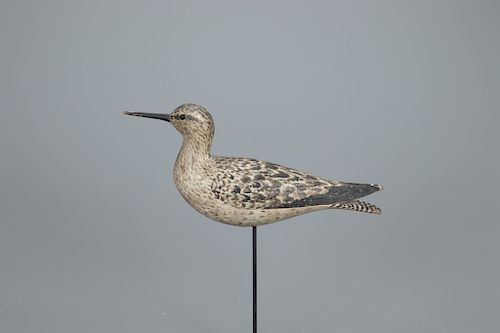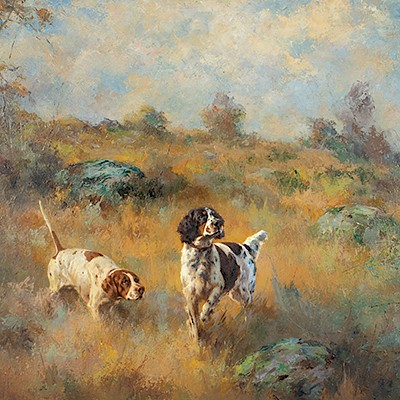"Dust-Jacket" Yellowlegs Decoy, A. Elmer Crowell (1862-1952)
About Seller
20 Winter Street
Pembroke, MA 02359
United States
Founded in 2005, Copley Fine Art Auctions is a boutique auction house specializing in antique decoys and American, sporting, and wildlife paintings. Over the course of the last two decades, the firm has set auction records for not only individual decoy makers, but also entire carving regions. Copley...Read more
Two ways to bid:
- Leave a max absentee bid and the platform will bid on your behalf up to your maximum bid during the live auction.
- Bid live during the auction and your bids will be submitted real-time to the auctioneer.
Bid Increments
| Price | Bid Increment |
|---|---|
| $0 | $50 |
| $1,000 | $100 |
| $2,500 | $250 |
| $5,000 | $500 |
| $10,000 | $1,000 |
| $25,000 | $2,500 |
| $50,000 | $5,000 |
About Auction
Feb 15, 2020
Charleston Marriott, 170 Lockwood Blvd., Charleston, SC 29403 Copley Fine Art Auctions cinnie@copleyart.com
- Lot Description
Dust-Jacket" Yellowlegs"
A. Elmer Crowell (1862-1952)
East Harwich, MA, c. 1910
13 in. long
Of the thousands of decoys that William J. Mackey Jr. owned in his lifetime, he selected just three birds for the cover of his early and influential volume "American Bird Decoys," published in 1965. These three "dust jacket" birds, along with a John Dawson merganser (lot 19), were also the only birds selected for the cover of a later reprinting in 1987. The shorebirds were all elaborately carved and painted by the father of American bird carving, A. Elmer Crowell. It was from collectors referencing this iconic book that the term “dust jacket” came to describe this exceptional carved-wing style that lasted just a short while. John and Shirley Delph’s 1981 book, "New England Decoys," also features a trio of related decoys on its dust jacket along with an early turned-head wood duck by the same maker. The Delphs' choice further cemented the moniker for this elite shorebird group. The brief period during which Crowell carved these elaborate working decoys was just prior to the the passing of the Migratory Bird Treaty Act of 1918, which outlawed nearly all shorebird shooting. Fortuitously for patrons and collectors, this shorebird gunning period coincided with the maker's greatest carving years, which is generally regarded as 1900-1915. Known for their variety of forms, exceptional paint patterns, grand scale, and beautifully carved primaries, Crowell took tremendous care in carving these early “dust jacket” decoys. The efforts that he imparted in carving these birds was simply too time consuming and he rather quickly abandoned the model all together. In fact, this wing-tip treatment, which virtually disappears from all of his work by 1920, acts as a marker for his stylistic changes.
An exceedingly rare "dust jacket" style yellowlegs, birds of this species and model rarely come to light; in fact, they are far less common than his renowned "dust jacket" plover.
Crowell’s most famous yellowlegs carving, and the most closely related yellowlegs decoy to this lot, is the open-bill calling yellowlegs seen on the dust jacket of the Harry V. Long Collection book. With its uplifted and drawn-back head and graceful neck, this grand carving showcases Crowell's unique ability to capture the semblance of movement in a gunning bird as well as any maker. The long and thin tail swoops slightly downward, completing a S-curve along the lower profile. The incised primaries extend for nearly six inches along the sides. The surface is finished with Crowell’s masterful paint techniques, including wet-on-wet blending throughout the mottled feather groups.
Original paint with minimal gunning wear including tiny chip to wing tips.
Provenance: Private Collection, Cape Cod
Literature: Copley Fine Art Auctions, “The Harmon ‘Dust Jacket’ Plover Trio,” The Sporting Sale, Hingham, MA, 2009, related plover illustrated.
Copley Fine Art Auctions, "The Harry V. Long Collection of A. Elmer Crowell Decoys," The Sporting Sale, Boston, MA, 2009, front dust jacket and lot 64, related calling yellowlegs illustrated.
Stephen B. O'Brien Jr. and Chelsie W. Olney, "Elmer Crowell: Father of American Bird Carving," Hingham, MA, 2019, pp. 122-125 and 210, related carvings illustrated.
William J. Mackey Jr., "American Bird Decoys," New York, NY, 1965, p. 64, pl. III, and dust jacket, related plover illustrated.
John and Shirley Delph, "New England Decoys," Exton, PA, 1981, dust jacket, related plover illustrated.
Robert H. Boyle, “With a Quack, Quack Here,” Sports Illustrated, September 27, 1971, p. 50, related example illustrated.Please email condition report requests to colin@copleyart.com. Any condition statement given is a courtesy to customers, Copley will not be held responsible for any errors or omissions. The absence of a condition statement does not imply that the lot is in perfect condition.Condition
- Shipping Info
-
Copley Fine Art Auctions does not handle the shipping of any items. Shipping is the sole responsibility of the buyer. Once your payment has cleared and we have received your authorized shipping release form items may be released for shipment. Copley Fine Art Auctions, LLC shall have no liability for any loss or damage to such items. Buyers should allow up to four weeks for shipment. Please email info@copleyart.com for a shipping form. Please be aware that internet bidders may NOT not pick up their items at the sale. Items will be available for pick up by appointment or by shippers five days after the sale.
-
- Buyer's Premium



 EUR
EUR CAD
CAD AUD
AUD GBP
GBP MXN
MXN HKD
HKD CNY
CNY MYR
MYR SEK
SEK SGD
SGD CHF
CHF THB
THB














